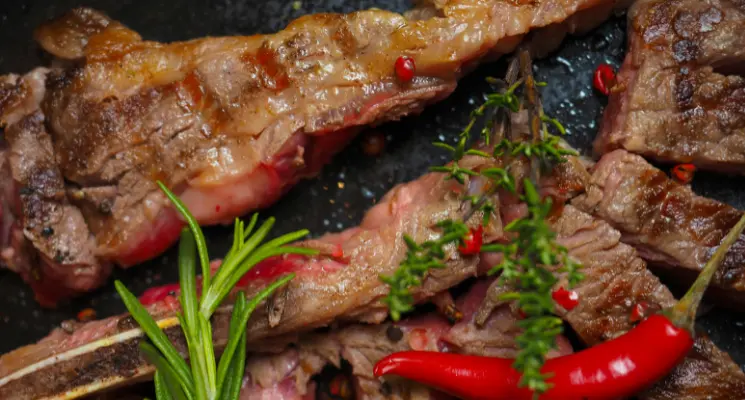Tender and juicy meat is not only a sign of a well-prepared dish. It’s the hallmark of a great culinary experience. Whether it’s a steak, roast, or any other cut, the texture and moisture of the meat significantly influence its taste and the eater’s satisfaction.
Achieving that perfect tenderness and juiciness can sometimes be a challenge, especially with cuts of meat that are inherently tough.
However, with a few simple tips and techniques, even novice cooks can master the art of making their meat dishes not just palatable but truly delectable.
In the following sections, we will explore six straightforward yet effective tips to help you ensure that your meat remains tender and juicy, transforming an ordinary meal into an extraordinary one.
1. Utilize Slow Cooking Methods
Slow cooking is an excellent method to transform tougher cuts of meat into tender, succulent delights. This method works wonders by gently breaking down the meat’s fibers over an extended period, allowing it to absorb flavors and retain moisture. A prime example of this technique is the deer roast made in a slow cooker. Deer meat, known for its lean texture, benefits significantly from slow cooking, which turns a potentially tough cut into a tender, flavorful dish.
The slow cooker deer roast recipe not only exemplifies how slow cooking can tenderize the meat but also demonstrates how this method infuses the meat with the flavors of herbs, spices, and broths it cooks in. By cooking the deer roast at a low temperature for several hours, the meat becomes incredibly tender and imbued with the rich flavors of the recipe’s ingredients.
2. Marinate to Enhance Flavor and Tenderness
Marination is a powerful technique to both tenderize and enhance the flavor of meat. The acids found in ingredients like vinegar, lemon juice, or yogurt break down protein structures in the meat, making it more tender. At the same time, the marinade’s flavors penetrate the meat, creating a more complex and robust taste profile. When marinating, it’s crucial to consider the type of meat and the appropriate marinating time, as overly long marination can lead to mushy textures.
Read More:- Must Have Kitchen Gadgets – 2024
For effective marination, ensure that the meat is fully immersed in the marinade and stored in the refrigerator during the process to prevent bacterial growth. Different meats require different marination times, ranging from a few hours for fish and seafood to overnight for tougher cuts of red meat. Experimenting with various marinade ingredients, from herbs and spices to oils and acids, can help you discover the perfect combination to both tenderize and flavor your meat, making each bite a tender, juicy delight.
3. Choose the Right Cut
The choice of meat cut is pivotal in determining the tenderness and juiciness of the final dish. Each cut has its characteristics and is suited to particular cooking methods. For instance, tender cuts like filet mignon are best for quick, high-heat cooking methods like grilling or pan-searing, while tougher cuts like brisket excel with slow, low-heat cooking methods that allow their connective tissues to break down.
Understanding the nature of different cuts and their ideal cooking methods can significantly enhance the tenderness and juiciness of your meat dishes. For example, cuts with more marbling (fat within the muscle) are likely to be more flavorful and juicier when cooked, as the fat melts and bastes the meat from within. Conversely, leaner cuts may benefit from marination or slow cooking to achieve a tender texture. By selecting the right cut for your cooking method and the desired outcome, you can optimize the texture and flavor of your meat, ensuring a delicious and satisfying meal.
4. Understand the Importance of Temperature
Cooking meat at the correct temperature is crucial for achieving the desired tenderness and juiciness. High temperatures can cause the proteins in the meat to contract too quickly, squeezing out moisture and resulting in a tough, dry texture. On the other hand, cooking meat at a lower, more controlled temperature allows the proteins to denature without losing too much moisture, ensuring the meat remains tender and juicy.
Using a meat thermometer is an excellent way to ensure you’re cooking your meat at the right temperature. Different types of meat and cuts require specific internal temperatures to be considered safe to eat and optimally tender. For instance, beef can be cooked to varying degrees of doneness, from rare to well-done, depending on the internal temperature reached during cooking. By understanding and applying these temperature guidelines, you can cook your meat to perfection, ensuring it’s both safe to consume and deliciously tender.
5. Utilize Mechanical Tenderizing Techniques
Mechanical tenderization is another effective method to make meat more tender. It can be as simple as using a meat mallet to physically break down the tough fibers and connective tissues in the meat. Another method is scoring, which involves making shallow cuts on the surface of the meat to help it cook more evenly and absorb marinades more effectively.
When using mechanical tenderization techniques, it’s important to strike a balance; excessive pounding or deep scoring can damage the meat’s structure, leading to a less desirable texture. For cuts that are already relatively tender, minimal mechanical tenderization may be needed. This method is particularly useful for tougher cuts that require a little extra help to become tender. By incorporating these techniques into your meat preparation routine, you can enhance the texture of your dishes, making them more enjoyable to eat.
6. Resting the Meat Post-Cooking
Resting the meat after cooking is a step that is often overlooked but is vital for retaining juices and ensuring tenderness. When meat is cooked, the heat causes the juices to move towards the center of the cut. When you let the meat rest after cooking, the juices inside, which have moved to the center during cooking, redistribute throughout the meat. This process helps to keep the meat moist and tender. If you were to slice the meat immediately after cooking, many of those flavorful juices would be lost, leaving your dish drier.
The length of time you should let the meat rest depends on its size; typically, a brief pause of 5 to 10 minutes suffices for smaller cuts, while larger roasts might need up to 20 minutes to properly redistribute their juices. During this time, the meat continues to cook slightly, a process known as carryover cooking, which should be accounted for when determining your initial cooking time. By allowing your meat to rest properly, you’ll ensure that each bite is as juicy and flavorful as possible.
Conclusion
Mastering the art of preparing tender and juicy meat is a valuable skill that can elevate your culinary creations to new heights. By understanding and applying these six simple tips – utilizing slow cooking methods, marinating, choosing the right cut, monitoring cooking temperatures, employing mechanical tenderization, and allowing the meat to rest –you can consistently achieve the perfect texture and flavor in your meat dishes.













